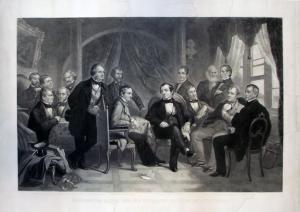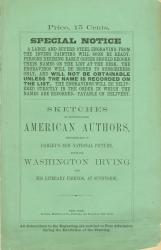Over several weeks in December of 1863, the following advertisement ran in the New York Times: “THE SENSATION OF THE DAY IS THE GREAT NATIONAL PAINTING!! OF WASHINGTON IRVING AND HIS LITERARY FRIENDS AT SUNNYSIDE BY F.O.C. DARLEY AND C. SCHUPELLE [sic] NOW ATTRACTING the attention of lovers of Art and Literature. ON EXHIBITION DAY AND EVENING, at the Derby Galleries, No. 625 Broadway.”
The single painting on view featured Irving in his Hudson River home with fifteen literary friends, including Longfellow, Cooper, Hawthorne, and others. An image of the painting, now at the National Portrait Gallery in Washington D.C., along with complete identification of the sitters can be found at: http://galleries.fototagger.com/link.php?action=detailimage&id=512&sort=0
The painting came quickly after Schussele’s 1862 success with Men of Progress, a similar painting representing nineteen distinguished American inventors. In fact, one 1863 reviewer begins by mentioning the lack of novelty in the design of such works. It was a common format to draw together prominent men, particularly in a time of war, when groups of generals and politicians were often seen in contemporary illustrated newspapers and journals.
However, the Washington Irving painting and engraving found tremendous success with the public. A small booklet was prepared and sold at the gallery describing the making of the two works, along with biographical sketches of each of the sitters.
According to the booklet and the press, the making of the engraving was a long and elaborate process. The original sketch or design was created by Felix Darley, who has a long history with Irving’s work and with the writer personally. To help with this drawing, Mathew Brady was hired to photograph the individual sitters. Some of these photographs can be seen today at the Library of Congress Prints and Photographs division. According to the Times, another final photograph was taken of the whole design, which is the source the engraver, Thomas Barlow, worked from over a period of three years. In a separate studio, Schussele rendered the work in oil.
The edition had four separate grades and prices. Artist’s proofs sold for $50, proofs before the lettering were $30, India proofs sold for $15, and the final prints for $10. The booklet was an extra 15 cents, which also gave you free admission during the exhibition of the painting. The introductory text of the booklet is so appealing that I include it in full. If you would like to read it, continue below.
The production of this charming picture will be universally regarded as a National event. It is, in the truest and completest sense, a National picture, and has an interest to the cultivators and lovers of American art, and American literature, which no work of the kind heretofore presented to the American Public can rival. From whatsoever point of view it may be regarded, artistic, literary, or personal, it challenges with a peculiar force the national acceptance, and the national admiration; presenting as it does the very embodiment and central unity of native genius. In every polite language of the earth, the distinguished persons here presented to us, stand, with greater or less relative prominence, the representatives of American literature, and culture. Where do the sunny thoughts, the tender human sympathies, and the flashing fancies of Geoffrey Crayon still remain unknown? And who of his countrymen does not willingly recognize in the immortal Knickerbocker, the pioneer and founder of his country’s literature? Where are the Leatherstocking tales, and the stirring sea stories of our great naval historian not known and admired of all readers? Who has rendered history a pastime and a delight, like the sprightly chronicler of the romantic and splendid series of events that characterized the early conquests of the magnificent savages of Mexico and Peru? When will the beautifully touching tale of Evangeline, the most pleasing and musical production in modern poetry, be unread and unadmired? Who, with a truer hand, or a more glowing touch than Bancroft’s, has traced the course and progress of our own unparalleled history? And so of the ever genial and humane autocrat, who still hesitates to be as funny as he can; of the Platonic and far-seeing sages of Concord, of Hawthorne, and Halleck, and Kennedy, and Simms, and Bryant, and Willis, and Tuckerman, who knows what sort of stuff men are made of, and Paulding, who had not a finger only, but his whole hand in Salmagundi—are they not all here, and is not their record written, and have they not shown themselves foremost, and able, and earnest, in establishing for their country a lasting and enviable literary fame? Yes, here they are—the loved and lamented Geoffrey the unassuming centre of the fraternal group. They have assembled for a morning’s conversation in the little Knickerbocker library at Sunnyside, a place dear to the recollection of all who have visited that classic spot. Irving sits in an easy, unaffected attitude, in his big arm chair, at once the honored host and genial companion of the distinguished party which surrounds him. Prescott, evidently the last speaker in the group, bends towards him his handsome intellectual face, in an earnest and inquiring manner, and behind him stands Longfellow, thoughtfully attentive for the momentarily expected response form the presiding spirit of the occasion. At the left hand of Irving sits Cooper, complacently conscious of his own brilliant fame, yet cordially recognizant of the still higher eminence of his great cotemporary. A little behind Cooper we see the happy, smiling face of Emerson, transcendently hopeful of all good things, and indifferently content with his Carlylian reputation as the most original thinker in America. The front line of this portion of the group includes, also, the strong decisive profile of Bancroft, in the attentive attitude of an expectant listener. Thus, we have, as the prominent interest of the picture, the admirable and life-like portraits of our great representative writers in History, Philosophy, Romance, and Poetry, naturally and characteristically disposed. The fine conception of the artist is now happily completed, and the picture enlivened by the introduction of other of the hospitable Knickerbocker’s friends and intimates, scarcely less distinguished in the literary world than those thus especially honored. Bryant stands near the window, pensively meditating on those melancholy days that annually cast their shade of sadness over nature’s varying face, and opposite him is seen Hawthorne, already wandering in imagination through those mysterious chambers in the House with the Seven Gables, through whose dusty windows was destined to stream the clear sunshine o his prolific fancy. Tuckerman is charging his memory with the characteristic points of the celebrities before him, and Willis is treasuring a “jotting-down” and a piquant item for his “Seeings and Hearings.” Worthy of mention. In short, each particular star of this brilliant galaxy, shines with its own peculiar light and magnitude, and appropriately fills its allotted place in this most charming and suggestive picture. Mr. Darley, to whose ever skilful pencil the country is indebted for both its design and execution, has but given us another evidence that whatever he undertakes to do he will do well. To secure accuracy, Mr. Darley availed himself of the services of the eminent photographer Brady. The picture has been reproduced in oil by Mr. Schuessele, with great fidelity to the original, making a beautiful and effective painting four feet by six, preserving in a remarkable degree the strength of handling and perfection of resemblance, which characterize the original drawing. It will be recollected that this fine drawing was made by Mr. Darley with the view of its being presented to the public in the form of an engraving. The working the plate has been in progress, in the hands of the distinguished English engraver, Thomas Oldham Barlow, for about three years, and is now rapidly approaching completion. It will be executed in the highest style of the art, combining the methods well known in the art-world as line and stipple. The size of the engraving will be twenty-two by thirty-one inches, taken on the heaviest and best of plate paper, forty-three inches long by thirty-one in width. A limited number of India proofs will be taken, and these will be issued only to subscribers, who will receive them in the order of their subscriptions.


Thank you for this wonderful posting. What a great tribute to Felix Darley and all those IN the drawing and the greats who worked on it. The details are most informative.
Does anyone know of the significance of the torn piece of paper in the forground of this engraving? I believe it signifies that some of the subjects are deceased but I cannot find a reference for it.
I have what appears to an original 1864 print by London Moore McQueen & Co. Any idea where I can authenticate this print?
Thank you for this posting. I recently picked up an engraved copy of "Washington Irving and his Literary Friends at Sunnyside". I am very excited about learning more about it. It needs some repair but still very sharp.
Any idea of the value of a copy?
I have a very old copy of this painting and would like to know its value and where I could sell it thank you
I would like to hear from anyone who could help me find out any information about this paintings value or who would know how or where i could sell it thankyou my number is 317-366-0296 please call me if you could be of any assistance